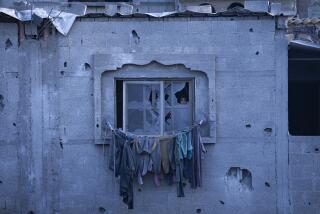Resilient City Now Wonders Whether It Can Bounce Back
- Share via
NEW YORK — In the panicky hours after the World Trade Center towers crumbled, Mayor Rudolph W. Giuliani and other officials here were defiant, vowing that the city would bounce back from Tuesday’s calamity.
“We’ve been tested before in New York and survived,” the mayor said. “We’re going to be here tomorrow. We’re stronger than these barbarians.”
But as horror grew over Tuesday’s attack, it was clear that the Big Apple’s psyche had taken a traumatic hit. The city’s bigger-than-life skyline and all that it represents had been crudely disfigured. And for every New Yorker who insisted the city would bounce back, others wondered whether it had been forever scarred.
As dust and debris continued to rain down, Manhattan ground to a halt: Long lines of survivors streamed out of the Wall Street area and began heading north, hoping to find some way to get home. Most were quiet and grim-faced. But every so often some would look back and gasp at the black cloud billowing from where New York’s tallest buildings once stood.
Strangers on the street who normally wouldn’t talk to each other couldn’t stop discussing the disaster. Sidewalks were jammed with New Yorkers swapping news bulletins that crackled over transistor radios; others tried to reach family members on cell phones that had suddenly stopped working.
In Times Square, people crowded into stores beaming TV broadcasts, anxious for the latest news. While public schools remained open, thousands of parents chose to take children home and had to walk miles to retrieve them. (City officials later announced that schools would be closed today.)
“I’ve seen things today I can’t ever forget,” said Ricky Fernandez, who works on Wall Street and sat numbly in the doorway of a midtown church. “We all have nightmares about these things happening in New York City. We’ve seen all the scary movies. But we don’t expect them to really happen.”
Widespread Confusion About Transportation
The doubts were fueled by massive transit and communication disruptions in America’s most populous city. By nightfall, there was still widespread confusion as to how many people living outside Manhattan would get home.
But mostly there was a growing realization that New York was more vulnerable to a catastrophic attack than many had dared believe.
“I still can’t accept this, it’s horrific,” said David MacGillivray, a Wall Street banker whose clothes were covered with dust from the explosion. He wore a dust mask around his neck and was walking several miles up Park Avenue to Grand Central Station, hoping to find a suburban train home.
“Today, some people tried to bring this city to its knees,” he added, wiping sweat from his face. “They shattered a lot of confident feelings.”
Two blocks away, the Church of Our Saviour was offering ice water, restrooms and solace to the armies of people walking north. Father Patrick Hennessey tried to assess the spiritual and psychological damage to his city.
“There’s nothing to compare with this, it’s a catastrophe for a generation that never lived through Pearl Harbor,” he said. “Today is a day for lamenting, because words are trite. But after tomorrow, I suspect there will be a lot of anger. A great many feelings, perhaps, of violation.”
The stunning destruction of the World Trade Center towers symbolized that anxiety. For all their griping about crime, traffic and noise, New Yorkers take a great deal of pride in the city’s physical grandeur. And in many ways, the 110-story World Trade Center towers epitomized the city’s self-image: They were dominant structures, sleek, modern and brutally commercial. A trip to the top could inspire wonder, but also feelings of fear and instability.
“New York is this huge, incredible, complex, powerful place. And suddenly it is made to look like anyone can walk in and destroy the place. . . . It’s a very, very serious incursion on your life,” said attorney Manfred Ohrenstein, who had to evacuate his office on the 85th floor of one of the World Trade towers. “It’s very hard for me to believe that these buildings are no longer standing. . . . I’ve lived with this landscape for much of my adult life.”
‘A Terrible Reality Check’
Some feared the city’s confident swagger might be slowed by the devastating terrorist attack.
“This is a terrible reality check for New York,” said Paul Harnett, a Metropolitan Transportation Authority official trying to keep a noisy crowd of commuters informed about the few trains still running out of Manhattan. “I mean, we’re a tough town. We get up if you knock us down. But what happened today could change life here. We lost something.”
In front of Grand Central Station, a group of commuters grew irate over conflicting reports of which trains were running. But they also bent over radios to hear the latest news and voiced fury over the attacks.
As she watched Giuliani on TV reassuring New Yorkers, Kathy Cooney said the unease and numbing shock on the streets was almost painful. But she firmly believed New York City could withstand the blow.
“We’ll find something positive from this,” the AOL-Time Warner buyer insisted. “I can’t believe how many perfect strangers are coming together and talking. It’s communication. Even the anger can be a unifying force.”
*
Times staff writer Paul Lieberman contributed to this story.
More to Read
Sign up for Essential California
The most important California stories and recommendations in your inbox every morning.
You may occasionally receive promotional content from the Los Angeles Times.










